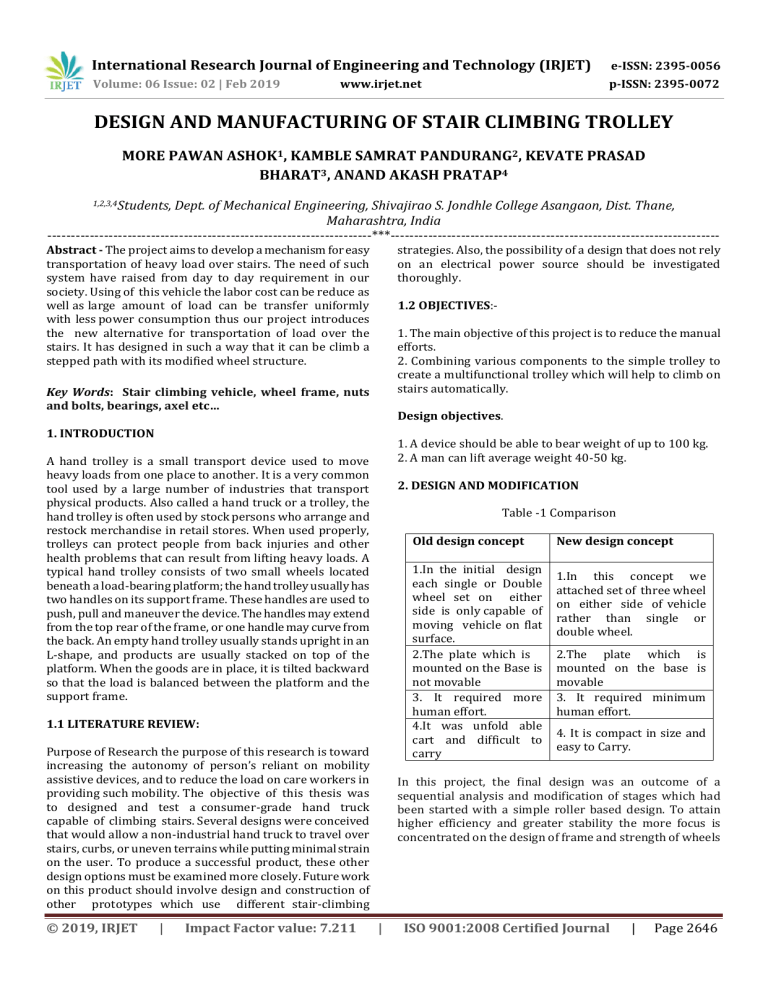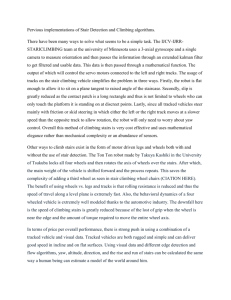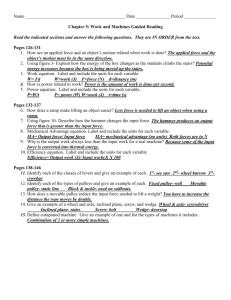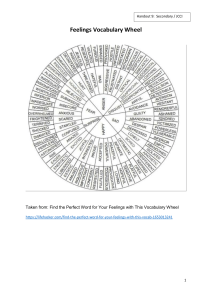IRJET- Design and Manufacturing of Stair Climbing Trolley
advertisement

International Research Journal of Engineering and Technology (IRJET) e-ISSN: 2395-0056 Volume: 06 Issue: 02 | Feb 2019 p-ISSN: 2395-0072 www.irjet.net DESIGN AND MANUFACTURING OF STAIR CLIMBING TROLLEY MORE PAWAN ASHOK1, KAMBLE SAMRAT PANDURANG2, KEVATE PRASAD BHARAT3, ANAND AKASH PRATAP4 1,2,3,4Students, Dept. of Mechanical Engineering, Shivajirao S. Jondhle College Asangaon, Dist. Thane, Maharashtra, India ---------------------------------------------------------------------***---------------------------------------------------------------------Abstract - The project aims to develop a mechanism for easy transportation of heavy load over stairs. The need of such system have raised from day to day requirement in our society. Using of this vehicle the labor cost can be reduce as well as large amount of load can be transfer uniformly with less power consumption thus our project introduces the new alternative for transportation of load over the stairs. It has designed in such a way that it can be climb a stepped path with its modified wheel structure. strategies. Also, the possibility of a design that does not rely on an electrical power source should be investigated thoroughly. 1.2 OBJECTIVES:1. The main objective of this project is to reduce the manual efforts. 2. Combining various components to the simple trolley to create a multifunctional trolley which will help to climb on stairs automatically. Key Words: Stair climbing vehicle, wheel frame, nuts and bolts, bearings, axel etc… Design objectives. 1. INTRODUCTION 1. A device should be able to bear weight of up to 100 kg. 2. A man can lift average weight 40-50 kg. A hand trolley is a small transport device used to move heavy loads from one place to another. It is a very common tool used by a large number of industries that transport physical products. Also called a hand truck or a trolley, the hand trolley is often used by stock persons who arrange and restock merchandise in retail stores. When used properly, trolleys can protect people from back injuries and other health problems that can result from lifting heavy loads. A typical hand trolley consists of two small wheels located beneath a load-bearing platform; the hand trolley usually has two handles on its support frame. These handles are used to push, pull and maneuver the device. The handles may extend from the top rear of the frame, or one handle may curve from the back. An empty hand trolley usually stands upright in an L-shape, and products are usually stacked on top of the platform. When the goods are in place, it is tilted backward so that the load is balanced between the platform and the support frame. 2. DESIGN AND MODIFICATION Table -1 Comparison Old design concept 1.In the initial design each single or Double wheel set on either side is only capable of moving vehicle on flat surface. 2.The plate which is mounted on the Base is not movable 3. It required more human effort. 4.It was unfold able cart and difficult to carry 1.1 LITERATURE REVIEW: Purpose of Research the purpose of this research is toward increasing the autonomy of person’s reliant on mobility assistive devices, and to reduce the load on care workers in providing such mobility. The objective of this thesis was to designed and test a consumer-grade hand truck capable of climbing stairs. Several designs were conceived that would allow a non-industrial hand truck to travel over stairs, curbs, or uneven terrains while putting minimal strain on the user. To produce a successful product, these other design options must be examined more closely. Future work on this product should involve design and construction of other prototypes which use different stair-climbing © 2019, IRJET | Impact Factor value: 7.211 New design concept 1.In this concept we attached set of three wheel on either side of vehicle rather than single or double wheel. 2.The plate which is mounted on the base is movable 3. It required minimum human effort. 4. It is compact in size and easy to Carry. In this project, the final design was an outcome of a sequential analysis and modification of stages which had been started with a simple roller based design. To attain higher efficiency and greater stability the more focus is concentrated on the design of frame and strength of wheels | ISO 9001:2008 Certified Journal | Page 2646 International Research Journal of Engineering and Technology (IRJET) e-ISSN: 2395-0056 Volume: 06 Issue: 02 | Feb 2019 p-ISSN: 2395-0072 www.irjet.net A. Modification of roller which only rolls over flat surface to the rollers which can climb the stairs: Fig : Tri-star wheel In the initial design, each single or double wheel set on either side is only capable of moving any vehicle on flat surface, but further study on same topic helps us to carry any goods on vehicle on stepped surface. In this concept we attached set of three wheels on either side of vehicle rather than single or double wheel. These tree wheels are attached to frame 120º apart with help of nut and bolt. 3. RECOMMENDATION FOR FUTURE RESEARCH A sensor and steering wheel can be implemented to move around the stairs. Sensor and moter would be a replace of a manual power, which runs the frame wheel. A suspension system could be incorporated to minimize shock and vibration. Using a timer circuit, the movement would be more precise, accurate and easy to operate. B. Modification of straight to curved wheel frame: The straight wheel frame takes more thrust to tilt the wheel frame to engage next planetary wheel. The length of each arm is high and thus creates vibration and the vehicle would be unstable. In the present design, the wheel frame was made curve so that the front surface of the arm could not collide with the edge of the stair. The optimization of the curvature was done to eliminate above problem. The curve wheel frame also requires less power to tilt compare to straight frame 4. CONCLUSION Though this project had some limitations regarding the strength and built of the structure, it can be considered to be a small step forward, as far as Stair Climbing Vehicles are concerned. During the test run of this project, it was realized that it wouldn’t be a bad idea to consider this design for carrying heavy loads up the stairs. This product will be well acclaimed if it can be commercialized to suit the needs. Though the initial cost of the project seemed to be higher but more accurate manufacturing would shorten this. As far the commercial aspects of this product are concerned, if this product can be fully automated and produced at a lower cost the acceptance will be unimaginable. Presently, there are no competitors for such a kind of production our market. C. Modified final design: In the first design, the power transmission to the single or double wheel trolley is useless to climb the stairs due to height factor of stairs creates huge obstacle on the way of vehicle. Also the design of the straight wheel frame became more complicated and was needed modified with its curvsphericle shape to give proper drive, which create more frictional force. For these reason, three wheel set on each side of vehicle attached with frame was introduced to provide smooth power transmission in order to climb stairs without obstacles. Frame arrangement is suitable to transmit exact velocity ratio also. It provided higher efficiency and compact layout with reliable service. Easier maintenance was possible in case of replacing any defective parts such as nut, bolt, washer, REFERENCES 1. Dr. R.K. Bansal, A text book of Strength of Materials, Laxmi Publications (P) Ltd. 2. R.S. Khurmi, J.K. Gupta, A textbook of Machine Design, S.Chand Publishing House 3. C. A. McLaurin and P. Axelson, Wheelchair standards: an overview. Journal of Rehabilitation Research and Development (Clinical Supplement). 27(2):100-103, 1990. 4 .Siegwart R, Lauria M, Mäusli P, Winnendael M. 1998, Design and Implementation of an Innovative Micro-Rover. © 2019, IRJET | Impact Factor value: 7.211 | ISO 9001:2008 Certified Journal | Page 2647 International Research Journal of Engineering and Technology (IRJET) e-ISSN: 2395-0056 Volume: 06 Issue: 02 | Feb 2019 p-ISSN: 2395-0072 www.irjet.net Proceedings of Robotics 98, the 3rd Conference and Exposition on Robotics in Challenging Environments, April 26-30, Albuquerque, New Mexico. 5. Hsueh-Er C, Stair-climbing vehicle, 2008. Patent No. US2008164665(A1)”, Jan 24. 6. Mourikis AI, Trawny N, Roumeliotis SI, Helmick DM, Matthies L. Autonomous Stair Climbing for Tracked Vehicles. International Journal of Computer Vision & International Journal of Robotics Research - Joint Special Issue on Vision and Robotics. 2007; 26(7): 737-758. © 2019, IRJET | Impact Factor value: 7.211 | ISO 9001:2008 Certified Journal | Page 2648


